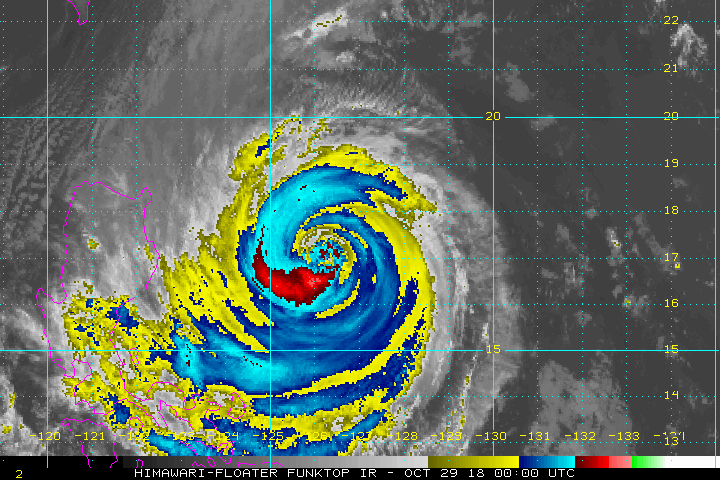
[ad_1]
Moderate to heavy rain and strong to very strong winds are expected to begin hitting Northern Luzon and Central Luzon on Monday, October 29
What’s the weather like in your area? Report the situation through Rappler’s Agos or tweet us at @rapplerdotcom.

Satellite image of Typhoon Rosita (Yutu) as of October 29, 2018, 8 am. Image from NOAA
MANILA, Philippines – More areas were placed under Signal No. 2 early Monday morning, October 29, as Typhoon Rosita (Yutu) headed for the Isabela-Aurora area.
In a bulletin released past 8 am on Monday, the Philippine Atmospheric, Geophysical, and Astronomical Services Administration (PAGASA) said Rosita is already 510 kilometers east of Tuguegarao City, Cagayan, or 475 kilometers east northeast of Casiguran, Aurora.
It is moving west southwest at a slightly faster 20 kilometers per hour (km/h) from the previous 15 km/h.
The typhoon maintained its strength, with maximum winds of 170 km/h and gustiness of up to 210 km/h. It has a wide diameter of 600 kilometers.
Signal No. 2 is now raised in:
- Cagayan
- Isabela
- Aurora
- Quirino
- Polillo Island
- Kalinga
- Mountain Province
- Ifugao
- Benguet
- Nueva Vizcaya
Signal No. 1, meanwhile, is up in:
- Ilocos Norte
- Ilocos Sur
- La Union
- Pangasinan
- Abra
- Apayao
- Batanes
- Babuyan Group of Islands
- Nueva Ecija
- Pampanga
- Tarlac
- northern part of Quezon
- Rizal
- Bulacan
- Metro Manila
- Laguna
- Batangas
- Bataan
- Zambales
- Cavite
- Camarines Norte

Moderate to heavy rain and strong to very strong winds are expected to begin hitting Northern Luzon and Central Luzon on Monday. (READ: #WalangPasok: Class suspensions, Monday, October 29)
On Tuesday morning, October 30, Rosita could make landfall in the Isabela-Aurora area. (READ: FAST FACTS: Tropical cyclones, rainfall advisories)
PAGASA warned that flash floods and landslides are possible in areas in the typhoon’s path. There might also be storm surges in coastal areas of Ilocos Norte, Ilocos Sur, La Union, Cagayan, Isabela, and Aurora. (READ: Cagayan braces for Typhoon Rosita a month after Ompong)
Sea travel is also risky in the seaboards of areas under tropical cyclone warning signals, as well as in the eastern seaboards of Southern Luzon, the Visayas, and Mindanao.
A gale warning was issued at 5 am on Monday for Batanes, the Babuyan Group of Islands, Calayan, Cagayan, Isabela, Ilocos Norte, Ilocos Sur, La Union, Pangasinan, Aurora, Zambales, Bataan, Camarines Norte, Camarines Sur, Catanduanes, the eastern coast of Albay, the eastern coast of Sorsogon, the eastern coast of Quezon including Polillo Island, Northern Samar, Eastern Samar, Surigao, Siargao, and Dinagat Islands.
Seas off those areas are rough to very rough, with wave heights reaching 2.6 meters to 4.5 meters.
PAGASA advised fishermen and others with small vessels not to set sail in areas covered by the gale warning. Larger vessels should watch out for big waves.
Based on Rosita’s latest forecast track, it will leave the Philippine Area of Responsibility on Wednesday, October 31.

Forecast track of Typhoon Rosita (Yutu) as of October 29, 2018, 8 am. Image from PAGASA
Rosita is the Philippines’ 18th tropical cyclone for 2018. The country usually gets an average of 20 tropical cyclones per year. (READ: LIST: PAGASA’s names for tropical cyclones in 2018)
PAGASA declared the start of the rainy season last June 8. – Rappler.com
[ad_2]Source link